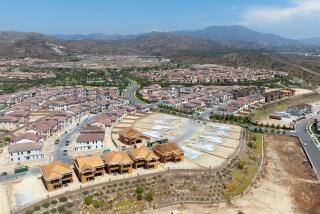Falling Value of ‘Edge’ Homes, Lots Pushes Developers to Brink : Housing: Bank is offering $58 million worth of mortgages in Riverside County at 23 cents on the dollar.
- Share via
In yet another sign of how far land values have fallen in Southern California’s once-popular “edge” developments, such as those in the arid hills east of Lake Elsinore in Riverside County, First Interstate Bank is selling its $58 million worth of mortgages on two large Lusk Co. projects in Menifee for 23 cents on the dollar.
An edge development is one located on the edge of an urban job center. Homes there typically are much less expensive than those located closer to the job centers, but residents face lengthy commutes for work and entertainment.
Home sales at Menifee, about 15 miles south of Perris and a 90-minute commute from Orange County, opened in the late 1980s, at the height of the Southland’s real estate boom.
Despite the searing summer heat and remote locale, soaring real estate in Orange County drove many home hunters there, and to other outlying or edge areas, in a quest for affordable housing.
But shoppers have stopped going such distances as prices in Orange County have tumbled in the recession. In 1989, the median price per square foot for a detached single family home in Orange County was $160. At the end of the first half of this year, that had plunged to $118. That’s a savings of more than $100,000 on a 2,400-square-foot house.
Although the falling prices mean better deals for consumers, they have caused many developers with large land holdings in rural areas to default on their loans because they cannot sell enough houses to generate the cash needed to stay current on their loan payments.
Lusk, a major home builder and land developer with headquarters in Newport Beach, defaulted on the Menifee loans earlier this year. In a recent offering circular, First Interstate has told prospective buyers it will take just $13.6 million for the notes on the properties. The mortgages cover a $54-million land acquisition loan and three commercial development loans, totaling $4 million, for a community retail center.
About half the 3,800 homes proposed for the 1,900-acre planned community have been built, but Lusk, as the general developer, has not sold any land to other home builders since 1990.
Even in areas where land still sells, it doesn’t sell for much these days, said Les Whittlesey, executive vice president of Hoffman Co., an Irvine land broker.
“If you have a parcel zoned for 100 units in a good location, you typically might have a dozen buyers chasing it today, where last year you’d only have had two or three,” Whittlesey said. “But they are buyers looking for quick sales and they aren’t offering much for it.”
And prices aren’t rising with demand, he said, because builders have to keep the retail prices of their homes so low that they cannot afford to pay anywhere near pre-recession prices for land.
In Victorville, for example, finished lots that builders paid $40,000 apiece for before the recession now go for 20% to 35% less, Whittlesey said. A finished lot is a parcel, zoned for a residence, that is graded and supplied with sewer and water systems and completed streets and curbs.
The closer it is to Orange County, the higher the lot’s price--but sometimes the bigger the discounts.
Kaufman & Broad Homes Inc. paid an average of $85,000 a lot last year for finished lots in Chino that had sold previously in 1989 at $145,000 per lot. That’s a 41% price cut.
There even are cases in which today’s economics make the land itself literally valueless--which helps explain why First Interstate would be willing to take a 77% discount on its Menifee loans.
“In 1989, a lot of land was sold in deals that anticipated a continuing inflation factor,” said Whittlesey. “A builder would pay 15% more than market value because he figured prices would keep going up.”
So the real value of a $100,000 lot was probably closer to $85,000. And $50,000 of that was the cost of streets, sewers, gutters and government fees for things like parks and schools, leaving the actual value of the dirt at about $35,000.
But the average lot is Southern California is worth 35% less than in 1989, when prices hit their peak. “So after you take away the 15% inflation factor, the only value left in that $100,000 lot is the $50,000 worth of improvements and fees,” Whittlesey said. The land itself is virtually worthless.
Economists, and brokers like Whittlesey, however, say that land values should start climbing again, perhaps as early as the middle of next year.
The supply of housing in Southern California--homes already built and lots that have cleared the planning process and are ready for building--has fallen to a 22-month supply, according to Market Profiles, a Costa Mesa real estate research firm.
And at current sales rates, the supply could fall to less than a year’s worth by next summer. When the housing inventory gets that low, demand starts outstripping supply and that forces prices to rise.
More to Read
Inside the business of entertainment
The Wide Shot brings you news, analysis and insights on everything from streaming wars to production — and what it all means for the future.
You may occasionally receive promotional content from the Los Angeles Times.










